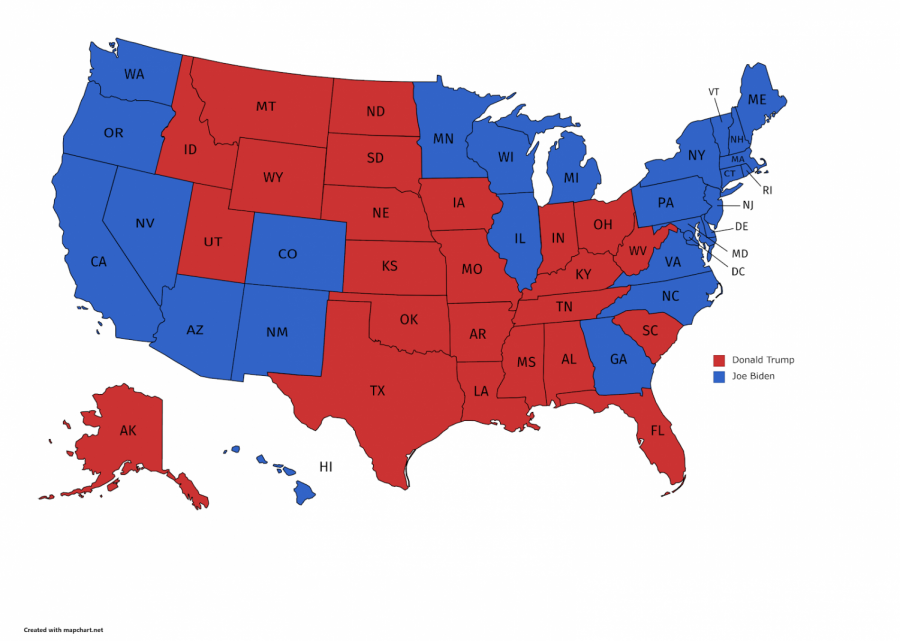A Walkthrough of the 2020 Presidential Election
The long awaited 2020 election is now at a close. Here’s how the votes came in.
A map of the electoral votes for the 2020 presidential election.
November 16, 2020
The 2020 presidential election has been viewed as both equally scary and important. Some key issues of the presidential race were COVID-19, race relations, the economy, and climate change. The eyes of both the Trump and Biden campaigns were focused on several battleground states consisting of Pennsylvania, Florida, Arizona, Wisconsin, and Michigan, with, of course, other states included. On Tuesday, November third, America watched the news to see the national results of the Electoral College, as well as predictions as to who would win each state. The following projections were made by both NBC News and Fox News.
Early in the night, the states of Kentucky, West Virginia, and Indiana were projected to fall to Trump, while Vermont and Virginia were leaning towards Biden. As the night progressed, Virginia would shift red for a while before ultimately returning to blue. As time went on, Oklahoma and Tennessee went to the GOP, with several east coast states, including Biden’s home state of Delaware, being projected to go to the Democratic Party. Just a few minutes before 7 p.m MST , Arkansas was projected to be in Trump’s hands. By 7 p.m, former Vice President Biden was projected with 51 votes, three ahead of President Trump.
Biden was projected to win New York almost immediately after the state closed polling. This was no surprise, as New York is a historically blue state. South Dakota was projected to fall red, followed by Colorado going for Biden. This was closely followed by North Dakota being predicted to follow its southern counterpart. Alabama and South Carolina went Republican, followed much later by New Mexico leaning towards Biden.
In a sudden burst of projections, Louisiana, Kansas, and Utah went red, with New Hampshire sticking with its neighbors and going blue. Soon after, Missouri was predicted to fall Republican, trailed closely by Illinois going for Biden. Nebraska, Mississippi, and Wyoming were the next states to be projected to vote for Trump.
Similar to New York, because of historically Democrat-voting populations, California, Oregon, and Washington were projected to vote for Biden as soon as polling closed. Florida, which was a state both candidates worked hard for, was taken by Trump, though Rhode Island went to Biden. Idaho went red.
After a long break, Ohio went to Trump, followed shortly by Texas, another key state for both parties. Hawaii was called to Biden, then Iowa to Trump. Over the night and through the morning, Hawaii and Minnesota officially went to Biden, while Montana chose Trump, leaving Biden ahead 238-213. It became apparent, though not totally certain, that Pennsylvania, Georgia, Alaska, and North Carolina would move red, with Wisconsin, Nevada, and Michigan going blue. If these predictions were true, Biden would ultimately win the race.
Later in the day, it was projected, though not entirely sure, that Wisconsin and Michigan would go blue. If that was the case, Trump would have no shot at winning. However, the Trump campaign released a statement saying that it would be filing a lawsuit against Michigan, Georgia, and Pennsylvania, as well as requesting a recount in Wisconsin. This was because of alleged suspicion regarding the voting in these states, says the Associated Press.
Over the following days, Pennsylvania, Georgia, and Arizona went to Biden, surprising Republicans, with North Carolina going to Trump. This left Biden at 306 electoral votes to Trump’s 232, closing out the 2020 election in Biden’s favor. Only time will tell how the nation will transition between presidents. Still, Americans across the country are hoping that our new president will be able to help us through the COVID-19 pandemic and economic downturns when he assumes office in January.















Careen • Nov 18, 2020 at 3:17 pm
Well done Carsten!